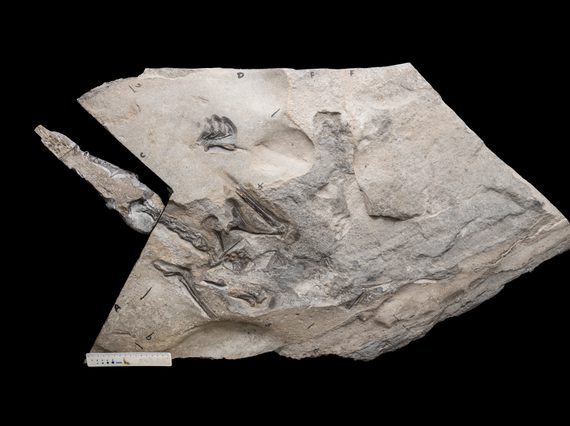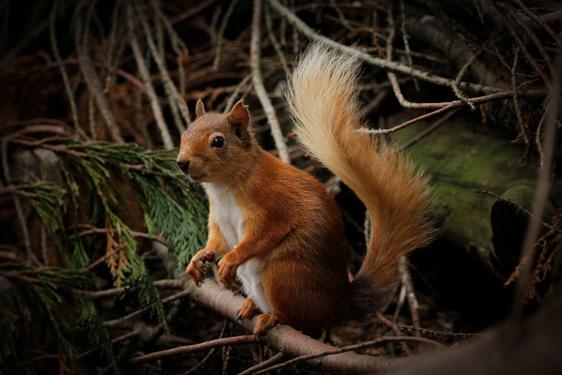
Illuminating the ‘dark age’ of pterosaur evolution: an exceptional skeleton from the Middle Jurassic of Skye, Scotland
Dr Natalia Jagielska successfully defended her thesis in 2024 after 4.5 years as a PhD student at the University of Edinburgh and co-supervised by National Museums Scotland.
Last updated: 18 February 2025
About the research
Pterosaurs - commonly known as ‘pterodactyls’ - are some of the most iconic extinct animals. These dinosaur cousins were the first vertebrates to evolve flight, and thrived for over 100 million years during the Mesozoic Era. Very little is known, however, about their evolution during the Middle Jurassic, due to a global lack of fossils. This is frustrating because this interval was likely a critical time in pterosaur history, when they transitioned from small, long-tailed, primitive forms into the great diversity of species that characterized their Mesozoic heyday.
Our team discovered the most complete skeleton of a Middle Jurassic pterosaur from the UK - and one of the most complete worldwide - in the Lealt Shale Formation of the Isle of Skye, Scotland. It revealed important insights into the anatomy, relationships, feeding habits, flight abilities, and favoured habitats of Middle Jurassic pterosaurs. The project comprised a detailed study, description, and identification of the new specimen, and used it as a springboard to examine the relationships and evolution of Middle Jurassic pterosaurs more broadly.
- Project title
Illuminating the ‘dark age’ of pterosaur evolution: an exceptional skeleton from the Middle Jurassic of Skye, Scotland
- Student
Natalia Jagielska
- Project active
2019 - 2024
- Funder
NERC Edinburgh Earth, Ecology and Environment (E4) Doctoral Training Partnership
- University Supervisors
Dr Stephen Brusatte and Dr Mark Wilkinson - School of GeoSciences
- National Museums Scotland Supervisor
- Research theme
Sustainability
Publications
Jagielska, N., Kaye, T.G., Habib, M.B., Hirasawa, T., Pittman, M. 2024. New soft tissue data of pterosaur tail vane reveals sophisticated, dynamic tensioning usage and expands its evolutionary origins. eLife 13. https://doi.org/10.7554/eLife.100673.2.sa2
Jagielska, N., O'Sullivan, M., Butler, I.B., Challands, T.J., Funston, G.F., Ross, D., Penny, A., and Brusatte, S.L. 2025. Osteology and functional morphology of a transitional pterosaur Dearc sgiathanach from the Middle Jurassic (Bathonian) of Scotland. BMC Ecology and Evolution 25: https://doi.org/10.1186/s12862-024-02337-9
Jagielska, N., Challands, T.J., O’Sullivan, M., Ross, D.A., Fraser, N.C., Wilkinson, M and Brusatte, S.L. 2023. New postcranial remains from the Lealt Shale Formation of the Isle of Skye, Scotland, showcase hidden pterosaur diversity in the Middle Jurassic. Scottish Journal of Geology 59: https://doi.org/10.1144/sjg2023-001
Jagielska, N., O’Sullivan, M., Funston, G.F., Butler, I.B., Challands, T.J., Clark, N.D.L., Fraser, N.C., Penny, A., Ross, D.A., Wilkinson, M. and Brusatte, S.L. 2022. A skeleton from the Middle Jurassic of Scotland illuminates an earlier origin of large pterosaurs. Current Biology: https://doi.org/10.1016/j.cub.2022.01.073
Project contact
Dr Nick Fraser
Lead image: Dearc Skeleton Main Block - credit Gregory Funston
Natural Sciences news and stories
- Discover

Scotland's native wildlife
Scotland is home to a wide variety of wildlife. Among the most recognisable species are red deer, which are monarchs of the glen, standing proud and majestic against the skyline.Scotland is home to over 90,000 species. The land, seas, and… - Discover

Meet ‘Lizzie’, a 345 million year old fossil
In the 1980s, a very important fossil was discovered in Scotland. Named Westlothiana, the fossil got its nickname 'Lizzie' because it looked so lizard-like. But don't let the name fool you. It was thought to be the oldest known reptile,… - Discover

The folky tale of the mineral tacharanite
This mineral got its name from how it behaves when exposed to air, but with a Scottish folkloric twist!Tacharanite occurs in nature as bundles and little spheres of silky white fibres in altered basalt rocks. It's found in several…